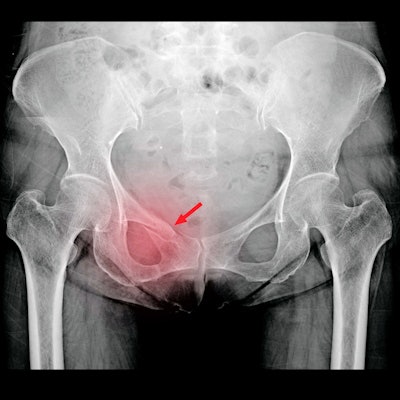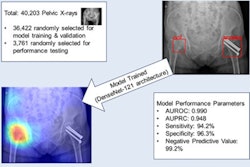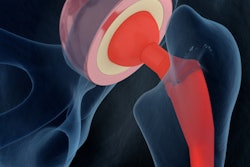
An artificial intelligence (AI) model was able to detect most types of trauma-related findings on pelvic radiographs, performing comparably to radiologists and orthopedic surgeons, according to research published online February 16 in Nature Communications.
Researchers led by co-first authors Dr. Chi-Tung Cheng of Chang Gung University in Taiwan and Yirui Wang of research company PAII in Bethesda, MD, trained a deep-learning algorithm to identify hip fracture, pelvic area fracture, hip dislocation, periprosthetic fracture, and femoral shaft fracture on pelvic radiographs. The algorithm -- called PelviXNet -- yielded an area under the curve (AUC) of 0.973 on a clinical test set of nearly 1,900 emergency department (ED) patients and also produced similar results to radiologists and orthopedic surgeons on a sample of 150 cases.
"Collaboration between the algorithm and physicians can improve the quality of trauma care," the authors wrote.
With the idea that an effective computer-aided diagnosis algorithm can prevent misdiagnoses and provide early warnings for life-threatening conditions, the researchers created PelviXnet to detect a wide range of trauma-related findings on pelvic radiographs.
"The ability to identify multiple categories of abnormalities at multiple sites concurrently in an image can increase a physician's trust in the algorithm and make it more feasible to use the algorithm widely in clinical practice," the authors wrote.
After training PelviXNet using 5,204 pelvic radiographs acquired at a trauma center from 2008 to 2016, they retrospectively tested the algorithm on pelvic x-ray exams from 1,888 patients who presented in the emergency room (ER) in 2017. PelviXNet achieved an area under the curve (AUC) of 0.972 for classifying normal and abnormal conditions, as well as 92.4% accuracy, 90.8% sensitivity, 93.2% specificity, 86.7% positive predictive value, and 95.4% negative predictive value on the test set.
The researchers then compared the algorithm's performance on a sample of 150 cases from the test set with that of 14 ER residents, four ER physicians, two orthopedic surgeons, and two radiologists. The 150 cases included 50 patients with hip fracture, 50 patients with a pelvic fracture, and 50 patients without acute findings.
| Accuracy of PelviXNet for detecting hip and pelvic fractures on radiographs | ||||
| ER residents (mean) | ER physicians (mean) | Radiologists and orthopedic surgeons (mean) | PelviXNet | |
| Hip fracture | 94.9% | 95% | 97.4% | 99.5% |
| Pelvic fracture | 89.3% | 90.3% | 94% | 94.5% |
Although PelviXNet's performance didn't differ significantly from that of radiologists and orthopedic surgeons, it did significantly outperform one of the ER physicians and five residents, according to the researchers.
"Some hip fractures and pelvic fractures that ER physicians missed could be detected with PelviXNet using the classification confidence scores and class activation heatmaps to indicate and localize findings," the authors wrote. "This means that frontline physicians can receive real-time recommendations from the algorithm when they are treating multiple trauma patients, as misdiagnoses can occur in a chaotic ER."
The researchers noted that prospective studies are now required to determine if PelvixNet could lead to more precise diagnoses in a clinical environment and facilitate trauma patient management.




















